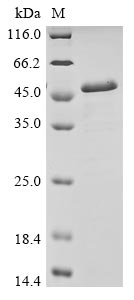Amino acids 1-330 constitute the expression domain of recombinant Escherichia coli (strain K12) rpoS. The calculated molecular weight for this rpoS protein is 42.1 kDa. Expression of this rpoS protein is conducted in e.coli. The rpoS gene fragment has been modified by fusing the N-terminal 6xHis tag, providing convenience in detecting and purifying the recombinant rpoS protein during the following stages.
The Escherichia coli RNA polymerase sigma factor RpoS is a key regulator of gene expression involved in the bacterial stress response. RpoS plays a crucial role in the transition from exponential growth to stationary phase, enabling E. coli to adapt to various environmental stresses. It controls the expression of genes related to survival mechanisms, such as oxidative stress resistance, nutrient limitation, and the general stress response. RpoS is essential for bacterial virulence and persistence in different environments. Its activity is tightly regulated at the transcriptional and post-translational levels, allowing E. coli to modulate its gene expression profile in response to changing conditions. Understanding the regulatory mechanisms of RpoS is important for unraveling bacterial adaptation strategies and developing strategies to control bacterial infections.






